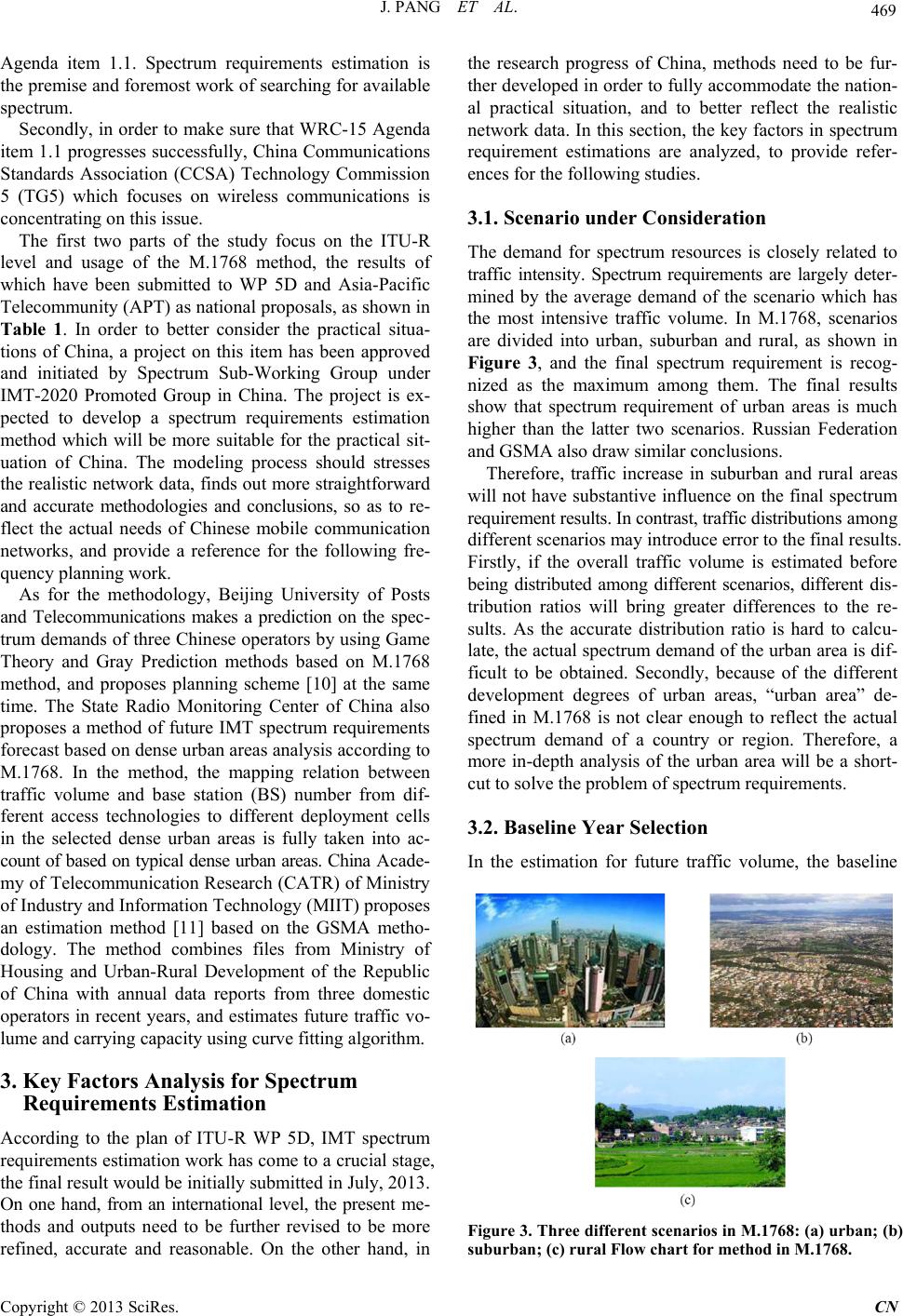
J. PANG ET AL.
Copyright © 2013 SciRes. CN
Agenda item 1.1. Spectrum requirements estimation is
the premise and foremost work of searching for available
spectrum.
Secondly, in order to make sure that WRC-15 Agenda
item 1.1 progresses successfully, China Communications
Standards Association (CCSA) Technology Commission
5 (TG5) which focuses on wireless communications is
concentrating on this issue.
The first two parts of the study focus on the ITU-R
level and usage of the M.1768 method, the results of
which have been submitted to WP 5D and Asia-Pacific
Telecommunity (APT) as national proposals, as shown in
Table 1. In order to better consider the practical situa-
tions of China, a project on this item has been approved
and initiated by Spectrum Sub-Working Group under
IMT-2020 Promoted Group in China. The project is ex-
pected to develop a spectrum requirements estimation
method which will be more suitable for the practical sit-
uation of China. The modeling process should stresses
the realistic network data, finds out more straightforward
and accurate methodologies and conclusions, so as to re-
flect the actual needs of Chinese mobile communication
networks, and provide a reference for the following fre-
quency pl a nning work.
As for the methodology, Beijing University of Posts
and Telecommunications makes a prediction on the spec-
trum demands of three Chinese operators by using Game
Theory and Gray Prediction methods based on M.1768
method, and proposes planning scheme [10] at the same
time. The State Radio Monitoring Center of China also
proposes a method of future IMT spectrum requirements
forecast based on dense urban areas analysis according to
M.1768. In the method, the mapping relation between
traffic volume and base station (BS) number from dif-
ferent access technologies to different deployment cells
in the selected dense urban areas is fully taken into ac-
count of based on typical dense u rban areas. C hina Acade-
my of Telecommunication Research (CATR) of Ministry
of Industry and I nf ormation Tec hno log y (MIIT) prop oses
an estimation method [11] based on the GSMA metho-
dology. The method combines files from Ministry of
Housing and Urban-Rural Development of the Republic
of China with annual data reports from three domestic
operators in recent years, and estimates future traffic vo-
lume and carrying capacity using curve fitting algorithm.
3. Key Factors Analysis for Spectrum
Requirements Estimation
According to the plan of ITU-R WP 5D, IMT spectrum
requirements estimation work has come to a crucial stage,
the final result would be initially submitted i n July, 2013.
On one hand, from an international level, the present me-
thods and outputs need to be further revised to be more
refined, accurate and reasonable. On the other hand, in
the research progress of China, methods need to be fur-
ther developed in order to fully accommodate the nation-
al practical situation, and to better reflect the realistic
network data. In this section, the key factors in spectrum
requirement estimations are analyzed, to provide refer-
ences for the following studies.
3.1. Scenario under Consideration
The demand for spectrum resources is closely related to
traffic intensity. Spectrum requirements are largely deter-
mined by the average demand of the scenario which has
the most intensive traffic volume. In M.1768, scenarios
are divided into urban, suburban and rural, as shown in
Figure 3, and the final spectrum requirement is recog-
nized as the maximum among them. The final results
show that spectrum requirement of urban areas is much
higher than the latter two scenarios. Russian Federation
and GSMA also draw similar conclusions.
Therefore, traffic increase in suburban and rural areas
will not have substantive influence on the final spectrum
requirement results. In contrast, traffic distributions among
different scenarios may introduce error to the final results.
Firstly, if the overall traffic volume is estimated before
being distributed among different scenarios, different dis-
tribution ratios will bring greater differences to the re-
sults. As the accurate distribution ratio is hard to calcu-
late, the actual spectrum demand of the urban area is dif-
ficult to be obtained. Secondly, because of the different
development degrees of urban areas, “urban area” de-
fined in M.1768 is not clear enough to reflect the actual
spectrum demand of a country or region. Therefore, a
more in-depth analysis of the urban area will be a short-
cut to solve the problem of spectrum requirements.
3.2. Baseline Year Selection
In the estimation for future traffic volume, the baseline
Figure 3. Three different scenarios in M.1768: (a) urban; (b)
suburban; (c) rural Flow chart for method in M.1768.